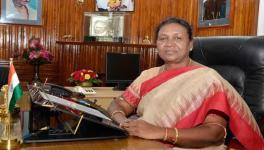After Crushing Ordeals, Millions Await Final NRC List in Assam
File Photo.
Abdul Wahab, a marginal farmer with 2 bighas of land, was relieved to see his and his relatives’ names in the second draft NRC list released on July 30 last year.
Nor did his kin or he figure in the additional exclusion list published this June, which left another 1.02 lakh people out of the citizenship roster – taking the official number of people excluded from the National Register of Citizens (NRC) in Assam to 41,10,169.
A year since the second draft — as more than 36 lakh people who re-applied with claims to citizenship anxiously await their future, to be announced on August 31 — not only is Abdul’s future any less uncertain, he has also been impoverished.
He is among thousands of villagers in the districts of Lower Assam — overwhelmingly rural, economically backward, rich in soil but devastatingly flood-prone, in the lower or western part of Brahmaputra river valley — who received arbitrary summons over August 3 and 4 to appear for NRC re-verification hearings. The hearings, were staggered across August 5, 6 and 7 in the towns of Upper Assam some 300-500 km away.
Abdul sold both of his cattle and mortgaged 1 bigha of his land for Rs 27,000 in order to literally overnight reserve a bus, so that the 47 people mentioned in his ‘legacy’ documents could rush over 300 km from Number 2 Barua Pathar village of Kamrup (rural) district in the Lower Assam division to Golaghat in Upper Assam.
Also watch: Who Killed Zabeda’s Baby? | Citizenship Crisis in Assam
While 45 of the relatives (including him) had been summoned under Claimant Notice (CN) type 1.1 (verification of own documents), two had been called under CN 2.1 (to bear witness for verification of family tree in legacy data).
As it turned out, there was no error in any of his ‘legacy’ documents.
“Apni marzi se bula liya (they called us on their whim),” said the 48-year-old, adding it would likely take him years to buy cattle again.
He is not the only one, more than a dozen people from across the four villages under Barua Pathar Gram Panchayat that NewsClick spoke to at a market square in No. 2 Barua Pathar village had no errors in their documents. Their names had already appeared in the draft NRC, if not in the first draft published on December 31, 2017, then at least in the second one.
Some said their papers were not even looked at, at the hearing centres.
Almost all of them, either marginal farmers or farm labourers, had sold their cattle — smaller, thinner cattle can fetch around 10-15K while bigger cattle up to 20K, said locals — and mortgaged some or all of their meagre landholdings, not more than 3-4 bighas at most.
Then there are those like Probina Begum, a 51-year-old school teacher in Number 1 Barua Pathar village, whose name did not feature in either the first or the second NRC draft.
But she was not called for the sudden re-verification hearings earlier this month. She did go for re-verification of her documents to Balisatra, some 70 km away within the same district, some days after last year’s second draft — which included her husband’s side of the family as well as her maternal family.
Her legacy documents to prove her citizenship included her father’s matriculation admit card and names on the 1966 voter list.
Asked what she would do if her name did not feature on the final NRC list, she said, “Nahi aayega toh phans gaye (If my name does not feature, I’ll be trapped)."
The inhuman proportions of chaos and crisis unleashed by these notices, flouting the rules that require at least 15 days of notice period, not 24 hours, have been intense enough to receive some coverage, though far from enough, in the mainstream national media.
Also read: NRC: Only 8.75 Percent of Those Left Out have Filed Claims
There have been reports after reports about how residents — mostly villagers in a poor state that has 86% rural population as per the 2011 census — have been struggling to prove that they and their families came to Assam before March 24, 1971: the cut-off date to be considered an Assamese citizen as the state undertakes to update its 1951 NRC.
Assam, a state that has had a history of ethnic conflict and ‘anti-immigrant’ sentiment, started the process of updating the NRC in 2013 as per a Supreme Court order. The total applicants for NRC inclusion were 3.29 crore.
Reports of those struggling to prove their identity, and being denied, include small children whose parents were included to even those serving (BSF officer and wife) or having served (former president’s nephew) the country. The reasons are varied – from lack of legacy data records to minor errors (spelling mistake, face not matching, etc.) in legacy data to even lack of government records itself.
There are also reports of people being impoverished fighting detention cases. But money and whatever meagre property/assets they owned is not all they have lost. Among other similar reports, a recent field survey this July found that the people excluded from NRC were suffering from extreme mental torture.
What Happens After August 31?
As lakhs of people await the final updated NRC list to be declared on August 31, what will happen to those who don’t make it? Will they be sent to the detention centres spread across the state? And how many people are expected to be left out this time — of the total 3.29 crore applicants, of which 3.96 lakh people did not or could not re-apply?
Analysts estimate that the number of exclusions are likely to range from “a minimum of 10-12 lakh to a maximum of 20-22 lakh”, many believing that “the NRC-exclusion list is likely to be split between migrant Muslims of Bengali origin and non-Muslims, a majority of them Bengal-origin Hindus.”
Also read: BJP Opposes NRC in Assam But Pushes It Across Country
The state unit of the Bharatiya Janata Party (BJP) is, of course, already creating ruckus over communal lines, voicing that “genuine” citizens (read Hindus) are likely to left out while “illegal foreigners” would make it.
Meanwhile, Assam Chief Minister Sarbananda Sonowal has tried to allay anxiety by stating that non-inclusion in NRC will not automatically make a person a “foreigner”.
Saying that only the Foreigners’ Tribunals (FTs) have the authority to declare a person a “foreigner” — 200 new FTs are being set up in addition to the existing 100 in anticipation of the post-NRC cases — Sonowal said those who were left out would be given "adequate" opportunity to present their case before the FTs.
Earlier, a home ministry statement said the government was amending the rules to double the time limit for filing appeals before the FTs from 60 days to 120 days.
The government and political parties have also announced legal aid for the “needy” people who are left out — besides the non-governmental organisations and civil rights activists’ groups who have relentlessly been helping out the people through the entire NRC updation process.
It remains to be seen, however, whom and how many among the lakhs of poor and toiling masses likely to be left stateless will the government recognise as “needy” and “genuine” — and on what basis.
Get the latest reports & analysis with people's perspective on Protests, movements & deep analytical videos, discussions of the current affairs in your Telegram app. Subscribe to NewsClick's Telegram channel & get Real-Time updates on stories, as they get published on our website.
























